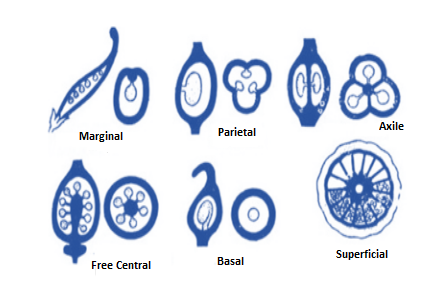
Describe the various types of placentations found in flowering plants.
Answer
336k+ views
Hint: Flowering plants, which are also known as angiosperms, use a sexual method of reproduction. Reproduction in plants rotates around the flower, which has both the female and the male gametes. All parts of a flower help in the process of reproduction, even though some of them are sterile.
Complete step-by-step answer:
Placentation indicates the structure, kind, formation and or arrangement of placentas. The area of the ovary wall in which the ovules are connected in a flower is known as the placenta. Several kinds of placentations found in flowering plants are
Marginal placentation The placenta makes a ridge along through the ventral suture of the ovary, ovules are borne on the ridge to form two rows. Example: Pea
Axile placentation The placenta is axial, and ovules are connected to it in a multilocular ovary. Example: Lemon
Parietal placentation Ovules evolve on the peripheral or on the inner wall of the ovary. It is single-chambered, but because of the development of a false septum, it turns into two-chambered. Example: Mustard
Basal placentation The placenta evolves at the base of the ovary in which a single ovule is connected to it. Example: Marigold
Free central placentation On the middle axis ovules are borne and septa are not present. Example: Primrose

Image:Placentation Types
Note: Placentation is the layout of ovules in the ovary of a plant. The function of placentation is to transmit respiratory gases, nutrients, and water from maternal tissue to a growing embryo, and in certain cases to eliminate waste from the embryo.
Complete step-by-step answer:
Placentation indicates the structure, kind, formation and or arrangement of placentas. The area of the ovary wall in which the ovules are connected in a flower is known as the placenta. Several kinds of placentations found in flowering plants are
Marginal placentation The placenta makes a ridge along through the ventral suture of the ovary, ovules are borne on the ridge to form two rows. Example: Pea
Axile placentation The placenta is axial, and ovules are connected to it in a multilocular ovary. Example: Lemon
Parietal placentation Ovules evolve on the peripheral or on the inner wall of the ovary. It is single-chambered, but because of the development of a false septum, it turns into two-chambered. Example: Mustard
Basal placentation The placenta evolves at the base of the ovary in which a single ovule is connected to it. Example: Marigold
Free central placentation On the middle axis ovules are borne and septa are not present. Example: Primrose

Image:Placentation Types
Note: Placentation is the layout of ovules in the ovary of a plant. The function of placentation is to transmit respiratory gases, nutrients, and water from maternal tissue to a growing embryo, and in certain cases to eliminate waste from the embryo.
Recently Updated Pages
What is glandular epithelium class 11 biology NEET_UG

The common characteristics between tomato and potato class 11 biology NEET_UG

Master Class 12 Business Studies: Engaging Questions & Answers for Success

Master Class 12 Economics: Engaging Questions & Answers for Success

Master Class 12 English: Engaging Questions & Answers for Success

Master Class 12 Maths: Engaging Questions & Answers for Success

Trending doubts
What is BLO What is the full form of BLO class 8 social science CBSE

Which places in India experience sunrise first and class 9 social science CBSE

The shortest day of the year in India

What are the major means of transport Explain each class 12 social science CBSE

Which are the Top 10 Largest Countries of the World?

How many millions make a billion class 6 maths CBSE




